Sugar and all its processed forms lurk in more foods than most people realize. And if you’re not paying close attention, these hidden sugars could be holding you back from reaching ketosis.
If your carb count is not within the keto-safe range of 20-50 grams (depending on your needs), your body won’t be able to use fat for energy effectively. So, before you conclude that keto “isn’t working,” you may need to take a closer look at hidden sugars in the foods you’ve been eating.
With a better understanding of where — and how — to spot these extra sugars disguised as dextrose, glucose, or fructose, you can eliminate them altogether.
Finding Hidden Sugars on Food Labels
Be wary of any foods with the following phrases on their label:
- No sugar added
- No refined sugar
- No added sugar
- 0g added sugar
No sugar added, no added sugar, and 0 grams of added sugar are the same thing: they all mean there’s no sugar added during the food’s manufacturing process. But that doesn’t mean the food is sugar-free.
Pepsi’s team tried this when it slapped the “no sugar added” label on its Naked Juice bottles, which can clock in around 27 grams of sugar for a half bottle and 64 grams for the whole thing[*].
Chances are if you see these claims on a product label, it already has too much sugar in it.
Different Names for Sugar
When you take into account both sugar and sugar alcohols, there are over 60 versions of sugar on the market[*]. The vast majority of these — even “natural sugars” and “natural sweeteners” — will raise your blood glucose levels. Avoid these sugars when you want to satisfy your sweet tooth:
- Fruit juice concentrate
- Glucose
- Fructose
- Invert sugar
- Granulated brown sugar
- Honey
- Malt syrup
- Maltose
- Maple syrup
- Table sugar or regular sugar
- Molasses
- Corn syrup
- Dextrose
- Coconut sugar
- Vegetable glycerin
- Agave
- Yacon syrup
- Honey
- Sucralose
You need to consider sugar, carb, and sugar alcohol amounts per serving, so be sure to scan through the ingredient list of any food you buy. The sooner the sugar appears on the ingredient list, the higher the concentration of sugar.
Different Names for Sugar From Corn: Is Dextrose Keto?
Not all sugar comes from sugar cane. Some sugars come from corn, beets, and other foods, but still act like sugar in the body. Which makes people wonder, are sweeteners like corn syrup, maltose, and dextrose keto-friendly?
Dextrose — like other examples listed above — is a simple sugar made from corn. Corn is not keto-friendly, and neither are its derived sugar products. Dextrose is a natural monosaccharide and carbohydrate, and acts just like glucose in your body.
Dextrose will raise your blood sugar levels, which could eventually lead to insulin resistance and prevent your body from raising its ketone levels. Therefore, you should avoid using it in keto recipes.
Different Names for Sugar Alcohols
Sugar alcohols, a popular sugar alternative, sound good on paper: These zero-calorie sweeteners have an incredibly sweet taste without the calories.
But, once again, don’t be fooled here. Some varieties contain enough net carbs to raise blood sugar and insulin levels[*]:
No added sugar and sugar-free foods must include the number of sugar alcohols (in grams) on the nutrition label by law. But if there’s more than one type of sugar alcohol being used, the amount in grams is hidden under the total carbohydrate number instead of being listed on its own as a sugar alcohol.
Pay attention to both figures when reviewing a product containing sugar alcohols. With sugar alcohols, you should subtract half of the total amount from your total carb count. So, if the label says there are 10 grams of sugar alcohols and 20 grams of carbs (30 total), the true adjustment becomes 15 grams of total carbs and 15 grams of sugar alcohols (half the combined total).
But how are you supposed to know what a sugar alcohol looks like? Sugar alcohols include:
- Mannitol
- Aspartame
- Maltitol
- Sorbitol
- Splenda
- Xylitol
- Isomalt
- Lactitol
- Saccharin
- Allulose
Why Should You Avoid Sugar Alcohols?
Sugar alcohols work their way through your system slowly — and they don’t ever fully digest. This is why they don’t affect your blood sugar levels as hard as real sugar. While the FDA has declared sugar alcohols “generally recognized as safe,” there are a few side effects you should know about.
Not only do sugar alcohols have a bitter aftertaste, but they can end up fermenting in your stomach and upsetting the healthy gut bacteria. This can then lead to unwanted and uncomfortable side effects such as gas, bloating, and other digestive issues[*]. Sugar alcohols can also have a laxative effect in some people, causing excessive diarrhea.
14 Foods (and Drinks) With Hidden Sugars
If you want to reach and maintain ketosis, you’re going to need to cut out the following foods from your diet.
#1: Sugar-Free Drinks
Sugar-free drinks may contain sugar alcohols, some of which may increase your blood sugar [*]. Even though you’re saving on the sugar count, you’re adding to your overall carb spend, which negates any possible “savings.”
#2: Protein Bars
Protein bars often contain rice syrup, honey, and molasses, which have high sugar content. Plus, with overly processed junk foods like these, you’re also jeopardizing your total carb budget. One single protein bar (such as the so-called healthy Kind bars) can be as high as half — if not all — of your carbs for the entire day.
#3: Green Smoothies
Steer clear of store-bought smoothies, even if they claim they’re only packed with green veggies and very few fruits or added sugars. See how this Naked Juice Green Machine smoothie stacks up:
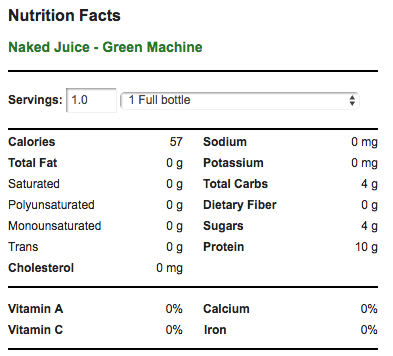
While not as bad as a tropical fruit smoothie, this bottle still clocks in 4 grams of sugar and zero fiber. If you’re trying to stay under 25 grams of carbs and 10 grams of sugar, this drink will eat up a huge chunk of that.
Freshly-made smoothies from juice bars aren’t any better. Check out how this Tropical Smoothie Detox Green compares:

That’s a whopping 48 grams of carbs and 32 grams of sugar in what’s being promoted as a “Detox Green Smoothie.” There’s nothing detoxifying about adding a bunch of carbs and sugar to your system.
The marketers at Trop50 are also trying to confuse you into thinking their updated version of orange juice with 50% less sugar and calories is safe to drink, even while you’re dieting. But this isn’t the case, especially on the keto diet. For example:
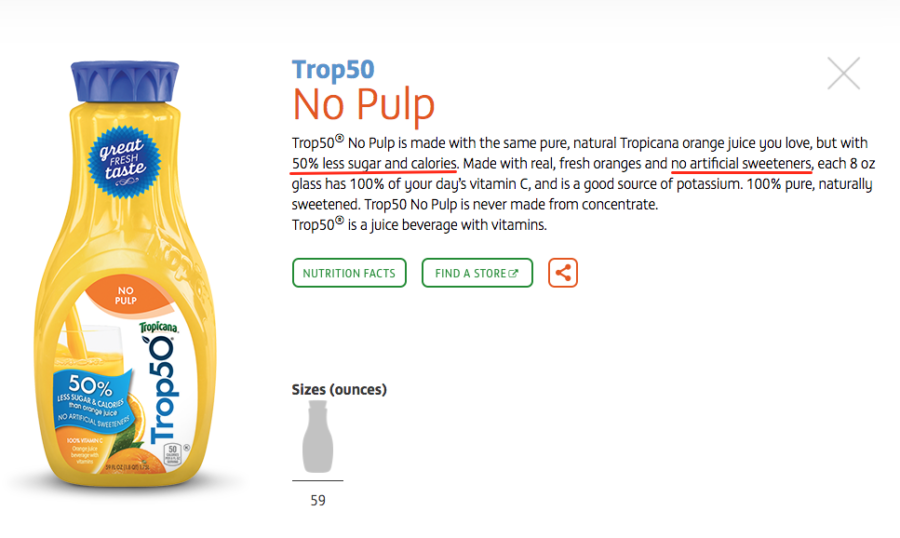
From looking at this, you’ll get half the sugar and calories and no artificial sweeteners in Trop50. Sounds good until you hit the nutrition facts:
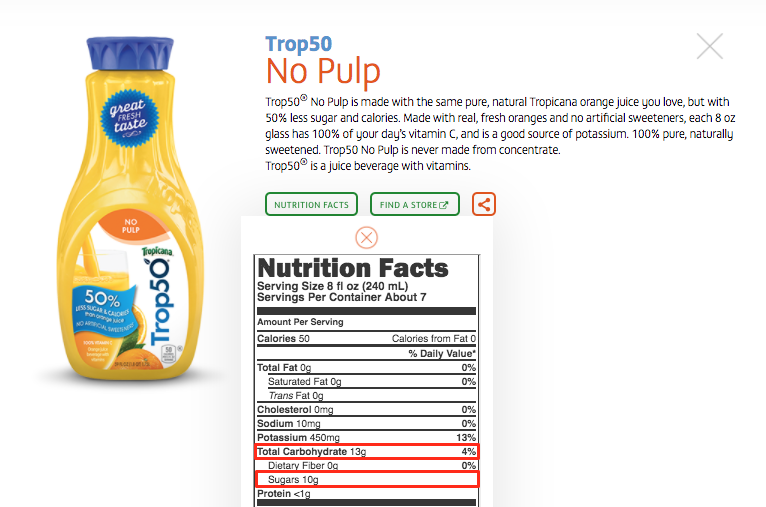
An 8-ounce glass is still 13 grams of carbs and 10 grams of sugar, two things that will definitely hurt your chances of reaching ketosis.
#4: Fruits (Even Keto-Friendly Ones)
Keto-approved fruits contain a precarious amount of sugar if you do not diligently measure your portions. Here’s the sugar count in one cup of:
- Raspberries – 5.5 grams
- Blackberries – 7 grams
- Strawberries – 7.5 grams
- Blueberries – 15 grams
#5: Veggies
Certain vegetables are excellent additions to your ketogenic diet — in moderation. It’s best to choose from this list of keto-approved veggies.
Go overboard with your veggies and they may have enough sugar in one cup to topple you out of ketosis[*]:
- Tomatoes – 4 grams
- Bell peppers (yellow, orange and red) – 6.3 grams
- Carrots – 6.1 grams
- Winter squash – 10 grams
- Sweet potatoes – 13 grams
- Sweet onions – 16.6 grams
#6: Asian Sauces
You know better than to order entrees like sweet and sour chicken since the sauce is sugar-based, and the meat is fried. But other sauces can fool you.
For example, beef and broccoli sound keto-friendly at first, but when you look closer, even homemade varieties have over 16 grams of sugar[*].
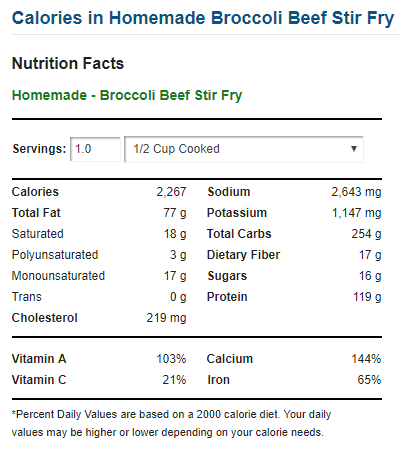
If you’re craving takeout, try keto-friendly alternatives like this shrimp stir fry, and you’ll shave off enough sugar and carbs to get one step closer to your weight loss goals.
#7: Anything Barbecued (With One Possible Exception)
Most barbecue sauces are made with ketchup, syrup, and brown sugar. Dry rub options may be the only exception, but even these are questionable on a low-carb diet. Spice mixes have hidden carbs, so you’ll need to account and adjust for this.
A better option is whipping up a batch of your own keto-friendly barbecue sauce or spice rub mix.
#8: Nut Butters
Whether peanut, almond, or cashew butter, certain jars can contain anywhere from 3-12 grams of sugar per serving — which is only two tablespoons.
So, unless you’re buying nut butter that’s made fresh and only includes the nuts themselves (such as the Perfect Keto nut butter), or you’re making your own, check the nutrition label for hidden sugars.
#9: Dairy
While dairy may help give you an added boost of fat, if you’re not on the defensive, it can also sneak in way too many sugars. For example, take a look at the macros of this 8-ounce glass of goat milk:
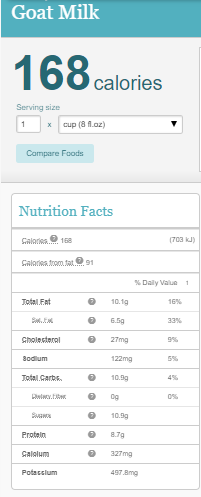
Many kinds of milk, yogurts, and cheeses contain lactose (although not all varieties do), which is a sugar composed of glucose and galactose.
When these sugars enter your bloodstream, they act just like refined sugar in candy and natural ones found in fruit. Low-fat and fat-free varieties are loaded with sugars to compensate for the lack of fat and flavor.
In the case of yogurt, reach for unflavored Greek yogurts and double-check the label and ingredient list to make sure there are no hidden sweeteners. As for milk, you’re better off grabbing a no-carb cheese stick instead of drinking a glass of milk if you want calcium. One glass of milk contains 7.9 grams of sugar and 12.8 grams of total carbs[*]:
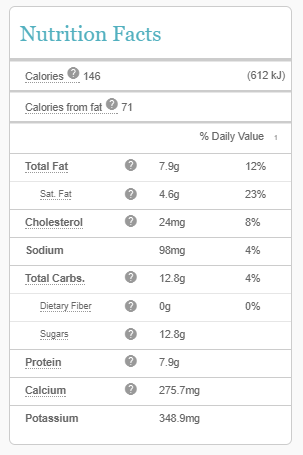
Opt for cheeses like blue cheese, gouda, mozzarella, and brie, and you’ll get a hit of fat without the added sugar. Here’s what a serving of blue cheese clocks in at:
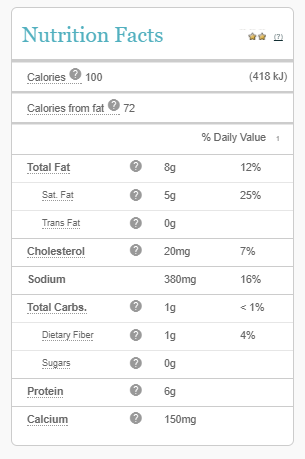
For more help separating the safe dairy on keto from those you should avoid, check out this guide when you’re done here.
And before you shrug your shoulders and think you’re in the clear because you buy non-dairy milk alternatives, check out this next section.
#10: Non-Dairy Milks
With the rise of alternative milk options like coconut, almond and even hemp milk, it may seem like a good idea to ditch the dairy and head for these.
Buyer beware here.
If you’re not used to these types of milks, they may not be your cup of tea. And then you’ll want a flavored variety to make it easier to drink.
Yet anytime you see flavors like vanilla or hazelnut, you could be adding as much as 9g of sugar per cup to your day[*].
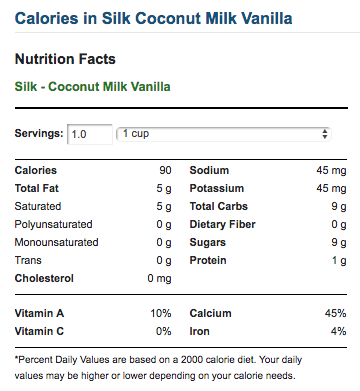
If you like the taste of unflavored milk alternatives, you’ll be in a much better place sugar-wise. Here’s how the macros change when the sweet flavor is removed: Instead of 9 grams, you’re down to 1 gram of sugar.
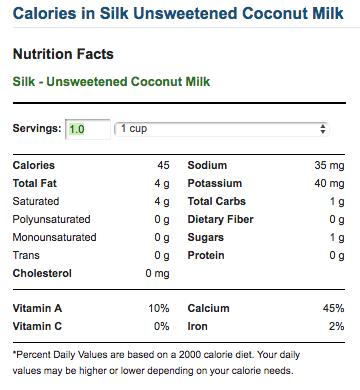
Stick to unflavored non-dairy milk — these have the fewest amount of carbs:
- Almond milk
- Pea protein
- Flax milk
- Hemp milk
#11: Salad Dressings
Hidden sugars run amuck in salad dressings. French, Russian, and Thousand Island dressings are all ketchup-based, so the sugar count can be astronomical. Balsamic-based dressings and vinaigrettes can also headline a sugar fest.
This single-serve Newman’s Own French dressing packet adds 13 grams of sugar to your greens[*].
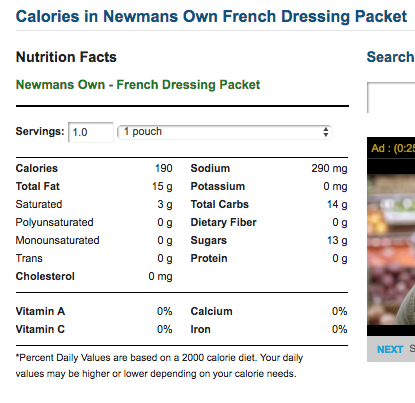
Even though you’re getting 15 grams of fat, that amount of sugar will negate all your hard work, and it certainly won’t help you achieve ketosis.
#12: Frozen Dinners and Entrees
Frozen foods are packed with hidden carbs. For example, this Lean Cuisine Steak Portabella low-carb frozen entree is clearly marketed towards low-carb dieters and possibly keto dieters[*].
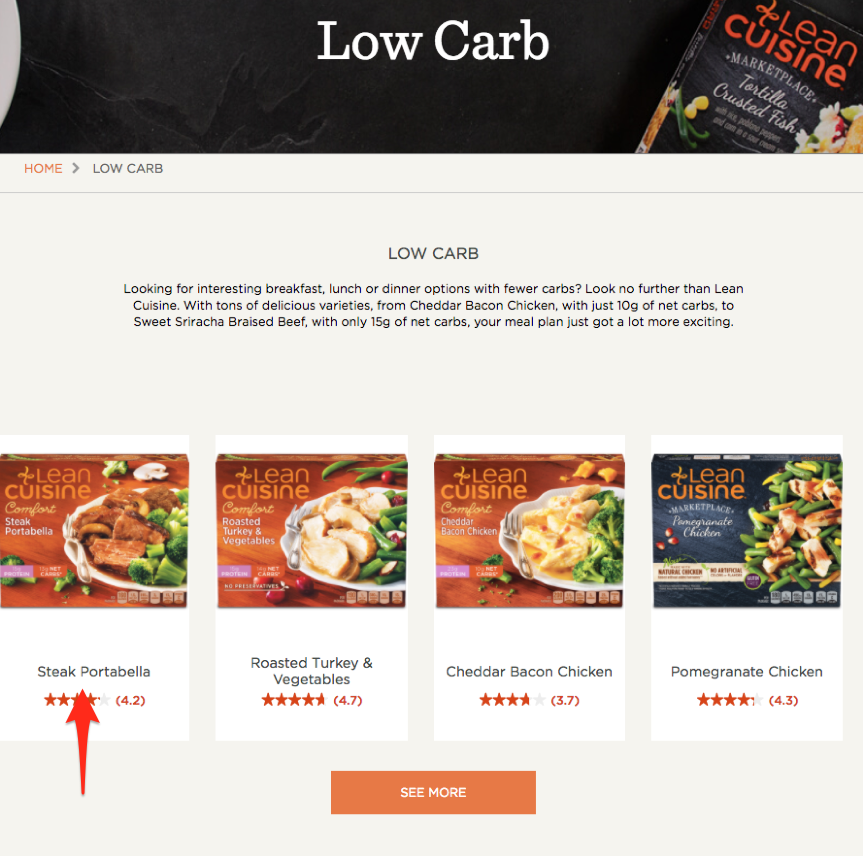
While the label only shows 3 grams of sugar, chances are, some of them are tucked away in the total carb count of 16 grams, which also isn’t very low-carb.
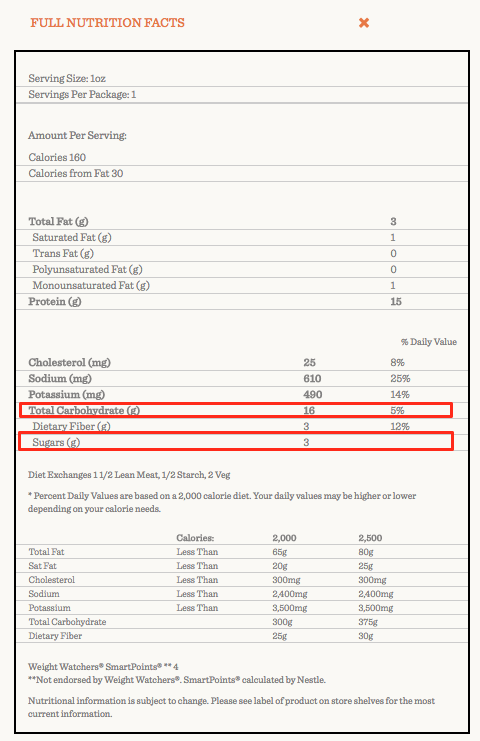
Check out the amount of sugars (in red) and additives buried in the ingredient list[*]:
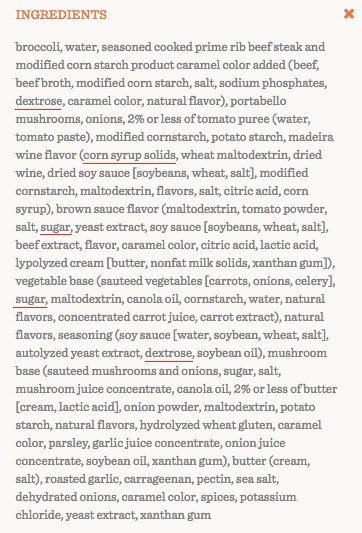
When it comes to frozen foods, it’s not just about low-carb. Pay attention to the hidden sugars and chemical additives too.
#13: Flavored Kombucha
As with many flavored drinks, kombucha can be a sugar bomb. While these added flavors and sugars may be in the form of real fruit, just like fruit smoothies, that doesn’t negate the amount of sugar hitting your system at a rapid rate.
Take this popular kombucha, for example:
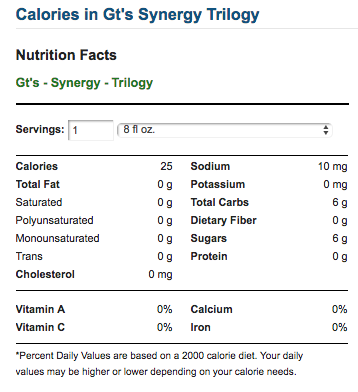
An 8-ounce glass has 6 grams of sugar, which equals 1 ½ teaspoons once it’s converted[*].
#14: Tonic Water
Tonic water is often confused with seltzer or soda water. While they both share clear, bubbly properties, one is loaded with sugar while the other doesn’t have any.
If the heading hasn’t made it clear, tonic water has more sugar in it than you think. This generic version has 23 grams of sugar to be precise[*]:
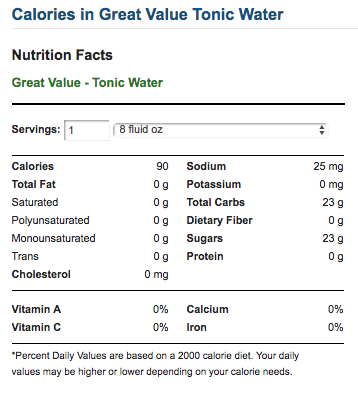
Yet that same brand’s seltzer gives you 0 grams of sugar[*]:
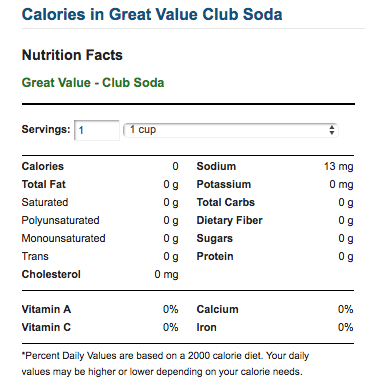
Whether you drink it as is, or you prefer it as your tequila or gin mixer, it’s time to switch to seltzer water if ketosis is your goal.
Keto-Friendly Sugar Substitutes
There are two primary low-carb sugar substitutes that work well for anyone who wants to replace sugar on keto. These alternatives contain zero carbs, zero calories, zero grams of sugar, and rank zero on the glycemic index, so they won’t raise your blood sugar levels.
Top keto sweeteners include:
- Stevia and stevia products, like Swerve
- Monk fruit sweetener and monk fruit extract
Others that work for some people, but may cause digestive upset for others, include:
- Erythritol
- Tagatose
Avoid Hidden Sugars to Help Reach Ketosis
You’re practically a hidden sugars detective by now — you may even predict where to find lurking sugars before you make the mistake of eating them.
Sleuth out all the ingredients listed on nutrition labels, and you’ll quickly cut down on your sugar intake. And when you do want to satisfy any sugar cravings, try these keto-friendly dessert recipes that use low-carb sweeteners like monk fruit or stevia.
Follow these guidelines, keep your carbs within a keto-friendly range, and you’ll be on your way to reaching ketosis.